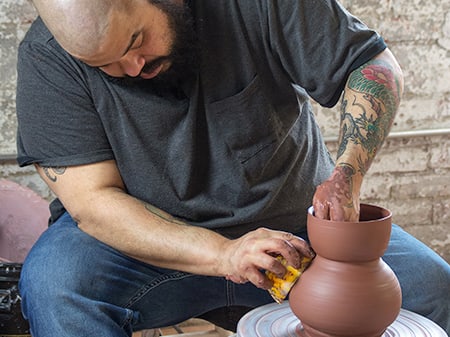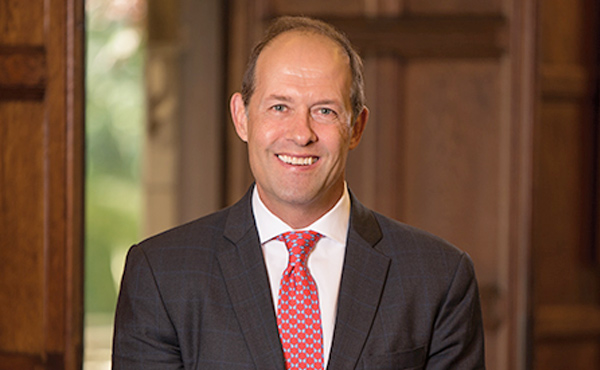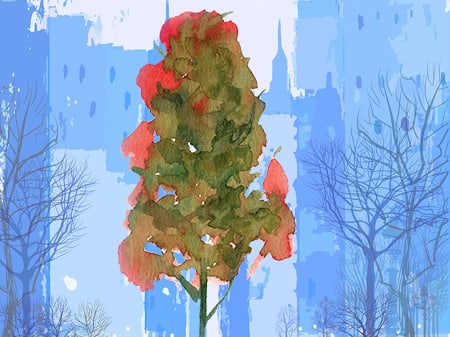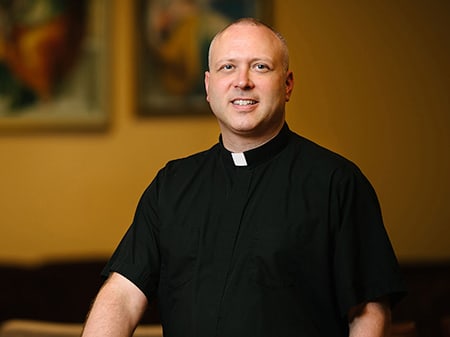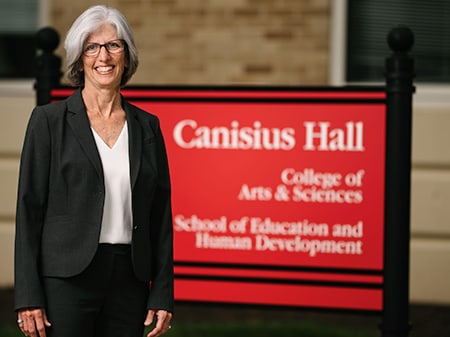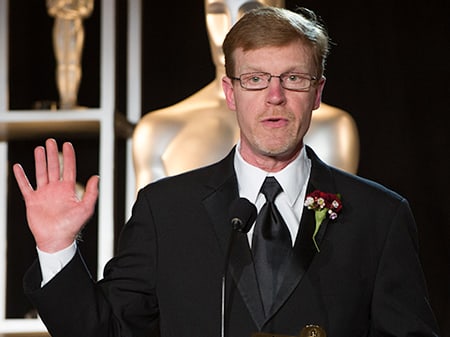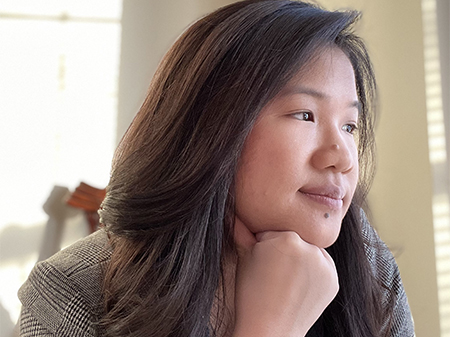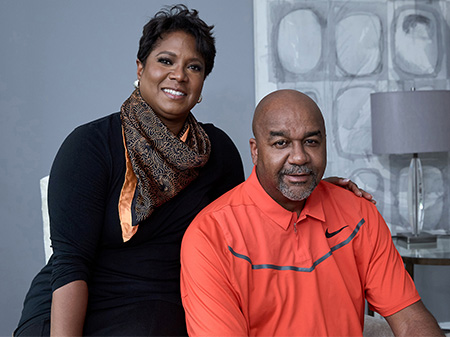Ceramicist, social activist, poet, and educator Roberto Lugo is one of three artists featured this fall at the Fairfield University Art Museum.
Lugo, a self-professed “ghetto potter” from Philadelphia, has turned the ceramics-porcelain-pottery world on its head in recent years. His work juxtaposes the precision of world-class ceramics and the delicacy of fine porcelain with an activist’s sensibility and streetwise flair.
— Alan Bisbort
With racial and social justice issues at the forefront of the cultural conversation, the Fairfield University Art Museum offers three exhibitions this fall that explore these themes.
The largest exhibition, Carrie Mae Weems: The Usual Suspects, showcases the work of Weems, a leading figure in the African American art community and a MacArthur ‘Genius Grant’ recipient. Installed at the Quick Center’s Walsh Gallery, The Usual Suspects contains Weems’ photographs and videos questioning racial stereotypes that associate Black bodies with criminality.
Augmenting this show, in the Bellarmine Hall Galleries, is Robert Gerhardt: Mic Check, an exhibition of photographs of Black Lives Matter gatherings that have taken place around the country since the murder of George Floyd in May of 2020.
A somewhat quieter but no less thought-provoking exhibition, Roberto Lugo: New Ceramics, is also installed in the Bellarmine Hall Galleries.
Lugo, a self-professed “ghetto potter” from Philadelphia, has turned the ceramics-porcelain-pottery world on its head in recent years, receiving, among other accolades, a 2019 Rome Prize and Pew Fellowship. His work juxtaposes the precision of world-class ceramics and the delicacy of fine porcelain with an activist’s sensibility and streetwise flair.
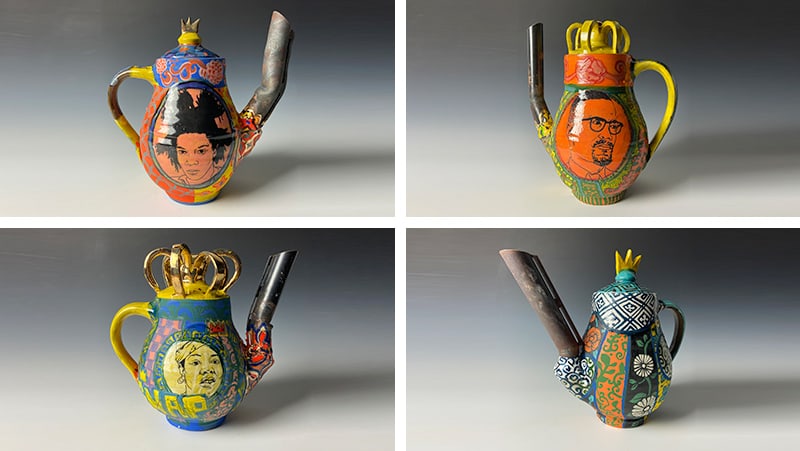
Roberto Lugo, Gun Teapot: Ida B. Wells and Jean-Michel Basquiat, 2021; Gun Teapot: Zora Neale Hurston and Malcolm X, 2021; Gun Teapot: Maya Angelou, 2021; Gun Teapot: Mae Jemison (back view), 2021, glazed ceramic, steel, epoxy, enamel. Photography by Dominic Episcopo, courtesy of the artist and Wexler Gallery.
“We see these three shows as a cohesive suite of exhibitions around the themes of racial justice and inclusion,” said Carey Mack Weber, the Frank & Clara Meditz Executive Director of the Fairfield University Art Museum. “The thing we love about Roberto’s work is that even though it is seen through the lens of racial issues and history, he is using the medium as more of an homage. His work is joyful and lifts up the viewers. It’s a great counterpoint to the other two exhibitions.”
Lugo, now an assistant professor at the Tyler School of Art and Architecture in Philadelphia, may be one of America’s most resourceful artists. He can be seen, in one remarkable YouTube video, wandering the litter-strewn city streets — he grew up in Philadelphia’s tough Kensington neighborhood — assembling a makeshift potter’s wheel from pieces of abandoned cars, a rope, some duct tape and a kitchen bowl. After gathering shovelfuls of dirt from an abandoned lot, Lugo sifts out the cigarette butts, syringes, bottle caps and then, with water from a nearby spigot, he molds that dirt into a moist ball of clay which he pounds, kneads, and spins into pots on his makeshift wheel.
“I made that video to function as a demonstration of resourcefulness, making the most out of what is at hand,” said the 40-year-old Lugo, speaking to Fairfield University Magazine from Manchester, N.H., where he conducted a summer residency at the Currier Museum.
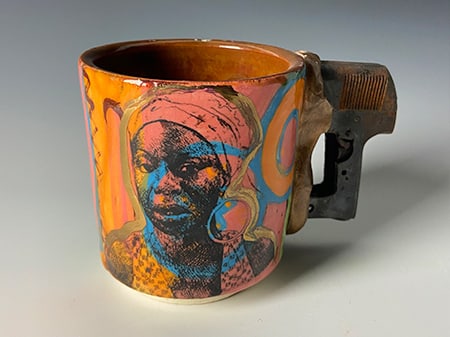
Peaceful Protesters: Nina Simone II, 2021
Back in his studio, under more precise and stringent conditions, Lugo creates porcelain teapots and earthenware plates, cups, bowls, and vases that are beautiful and colorful but also serve a utilitarian purpose and carry a potent message. Instead of the dainty floral patterns, scenes at royal court and the like found in stately porcelain of yore, Lugo’s teapots and earthenware carry portraits of Frederick Douglass, Malcolm X, Sojourner Truth, John Brown, Angela Davis, Colin Kaepernick and Tupac Shakur.
Nine of Lugo’s provocative teapots will be included in his New Ceramics exhibition at the Bellarmine Galleries, along with some cups and a large vase.
“Roberto started out as a graffiti artist and there is some of that same energy and vibrancy in his ceramics and earthenware,” said Weber.
“Graffiti is sort of a response by artistically inclined people who have no other outlet due to their circumstances,” Lugo explained. “That same energy comes into my studio in the sense that I feel my work is an act of resistance. Yes, I am acknowledging racism in my work, but it is also a celebration of Black heroes.” Making ceramics, Lugo told a National Council on Education for the Ceramic Arts (NCECA) audience in 2015, is a metaphor for his life. Born in a devoutly religious Puerto Rican family — his father was a pastor — he nonetheless had to learn to navigate some mean streets.
“I grew up in an era with drugs and prostitution in my neighborhood,” he said. “This made me feel sheltered and afraid to go out. We went to church every day. I never cursed, never talked back, and yet I was judged for being ‘brown’.”
His artistic inclinations found an outlet in graffiti as a teenager, but they only fully flowered once he left Philadelphia at age 22, after working various factory jobs for four years in the city. He moved to South Florida to live with family and decided to enroll in a ceramics class at a community college. This is when he began infusing this artform — traditionally more of a utilitarian craft than a fine art — with echoes of his urban past. It felt both natural and profound to him.

Texture Study 1, 2021, glazed ceramic. Both courtesy of the artist and Wexler Gallery.
On the strength of the work he created in Florida, Lugo was accepted into the ceramics arts program at the Kansas City Art Institute, where he graduated with a BFA in 2012. In addition to the artwork, he began deeply researching the history of ceramics, which led him to anthropological studies about the roles of pots and bowls in past cultures. This is when it occurred to him that he could bring his expertise in graffiti to the surfaces of the vessels he was creating in the studio.
Returning to Pennsylvania, he enrolled in graduate school at Penn State University School of Visual Arts in 2012 and had something of an epiphany the following year when photographer Richard Ross came to campus to critique students in the photography department. Lugo waited outside the critique room for Ross, with a backpack full of his ceramics. Not only did Ross, whose work primarily focuses on incarcerated youth, praise the work, he invited Lugo to collaborate on an exhibition about prison life. As Lugo’s brother had recently been incarcerated on a drug charge, the invitation was a turning point for him. “This is the power of ceramics,” he said. “I felt that I was empowered to do anything, and that my voice was an important and needed component to the ceramics community.”
“In many ways, my work connects people from different perspectives,” Lugo said, about the Fairfield University exhibition. “Experts on porcelain will know the history of the tradition. But those who don’t will still be able to connect with the history of the people I’m celebrating in my work. My hope is that it is a physical representation of the beauty that happens when we come together as people from different backgrounds. That’s the magic of art, combining different things to create a work.”
In addition to the New Ceramics exhibition at Fairfield University, Lugo’s work will be featured in Before Yesterday We Could Fly: An Afrofuturist Room, a groundbreaking exhibition opening in November at the Metropolitan Museum of Art in New York City.
“Art can say things we can’t say in words,” said Lugo. “It’s a form of wordless communication, like music. I am giving recognizable objects a newness and freshness. Can you really argue that diversity is not beautiful?”
